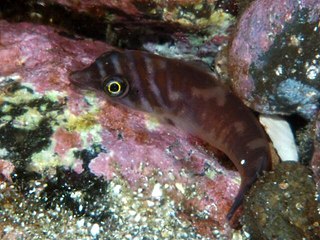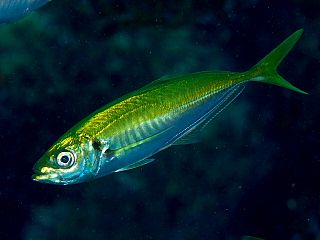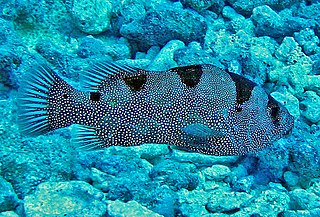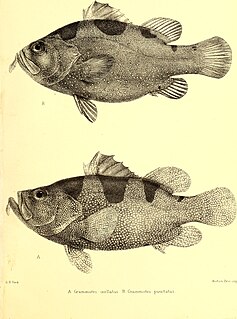
Pollock or pollack is the common name used for either of the two species of North Atlantic marine fish in the genus Pollachius. Pollachius pollachius is referred to as pollock in both North America and the United Kingdom, while Pollachius virens is usually known as coley in the British Isles. Other names for P. pollachius include the Atlantic pollock, European pollock, lieu jaune, and lythe; while P. virens is also known as Boston blue, silver bill, or saithe.

The Percidae are a family of ray-finned fish, part of the order Perciformes, which are found in fresh and brackish waters of the Northern Hemisphere. The majority are Nearctic, but there are also Palearctic species. The family contains more than 200 species in 11 genera. The perches, and their relatives are in this family; well-known species include the walleye, sauger, ruffe, and three species of perch. However, small fish known as darters are also a part of this family.

The Lamniformes are an order of sharks commonly known as mackerel sharks. It includes some of the most familiar species of sharks, such as the great white, as well as more unusual representatives, such as the goblin shark and megamouth shark.

The Carangidae are a family of ray-finned fish which includes the jacks, pompanos, jack mackerels, runners, and scads. It is the largest of the six families included within the order Carangiformes. Some authorities classify it as the only family within that order but molecular and anatomical studies indicate that there is a close relationship between this family and the five former Perciform families which make up the Carangiformes.

Sander is a genus of predatory ray-finned fish in the family Percidae, which also includes the perches, ruffes, and darters. They are also known as "pike-perch" because of their resemblance to fish in the unrelated Esocidae (pike) family. They are the only genus in the monotypic tribe Luciopercini, which is one of two tribes in the subfamily Luciopercinae,

Pompanos are marine fishes in the genus Trachinotus in the family Carangidae. Pompano may also refer to various other, similarly shaped members of the Carangidae, or the order Perciformes. Their appearance is deep-bodied, toothless, with a forked tail and narrow base. They are typically overall silvery in color, sometimes with dark or yellowish fins, and one or a few black markings on the side of their body. They are relatively large fish, up to about 1.2 m (3.9 ft) long, although most species reach no more than half or two-thirds of that size. They are found worldwide in warmer seas, sometimes also entering brackish waters.

Clingfishes are fishes of the family Gobiesocidae, the only family in the order Gobiesociformes. These fairly small to very small fishes are widespread in tropical and temperate regions, mostly near the coast, but a few species in deeper seas or fresh water. Most species shelter in shallow reefs or seagrass beds, clinging to rocks, algae and seagrass leaves with their sucking disc, a structure on their chest.

Jack mackerels or saurels are marine fish in the genus Trachurus of the family Carangidae. The name of the genus derives from the Greek words trachys ("rough") and oura ("tail"). Some species, such as T. murphyi, are harvested in purse seine nets, and overfishing has sometimes occurred.

Atherina is a genus of fish of silverside family Atherinidae, found in the temperate and tropic zones. Up to 15 cm long, they are widespread in the Mediterranean, Black Sea, Sea of Azov in lagoons and estuaries. It comes to the low stream of the Dnieper, Southern Bug, Dniester and Danube Rivers.

Mycteroperca is a genus of marine ray-finned fish, groupers from the subfamily Epinephelinae, part of the family Serranidae, which also includes the anthias and sea basses. They are predatory fish, largely associated with reefs and are found in tropical and subtropical seas in the Atlantic Ocean and the eastern Pacific Ocean. They are important target species for fisheries.

Plectropomus, commonly known as the coral groupers, is a genus of marine ray-finned fish, groupers from the subfamily Epinephelinae, part of the family Serranidae, which also includes the anthias and sea basses. They are found in the Indo-Pacific region.

The Catostomidae are the suckers of the order Cypriniformes, with about 78 species in this family of freshwater fishes. The Catostomidae are almost exclusively native to North America. The only exceptions are Catostomus catostomus, found in both North America and Russia, and Myxocyprinus asiaticus found only in China. In the Ozarks they are a common food fish and a festival is held each year to celebrate them. Ictiobus cyprinellus can reach an age up to 112 years, making it the oldest known freshwater teleost.

Bangana is a genus of fish in the family Cyprinidae, the carps and minnows. It is distributed across much of southern and eastern Asia. Species live mainly in the flowing waters of tropical and subtropical rivers.

Rypticus is a genus of marine ray-finned fish, related to the groupers and classified within the subfamily Epinephelinae of the family Serranidae. It is one of several genera of soapfishes. These fish live in the Atlantic and eastern Pacific Oceans in tropical and warmer temperate zones.

Paranthias is a genus of marine ray-finned fish, groupers from the subfamily Epinephelinae, part of the family Serranidae, which also includes the anthias and sea basses. They are found in the Atlantic Ocean and the eastern Pacific Ocean.

Caprodon is a small genus of fish belonging to the subfamily Anthiinae. It contains three species.

Diploprion bifasciatum, the barred soapfish, also known as the doublebanded soapfish, two banded grouper, two-banded sea perch, two-banded soapfish, yellow emperor or yellow striped grouper, is a species of marine ray-finned fish, related to the groupers and included in the subfamily Epinephelinae which is part of the family Serranidae, which also includes the anthias and sea basses. It is found in the Indo-Pacific region.

Pogonoperca is a genus of marine ray-finned fish, related to the groupers and classified within the subfamily Epinephelinae of the family Serranidae. They are found in the Indo-Pacific region.

Pogonoperca ocellata, the Indian soapfish or snowflake soapfish, is a species of marine ray-finned fish, related to the groupers and classified within the subfamily Epinephelinae of the family Serranidae. It is found in the Indian Ocean.
Belonoperca is a genus of marine ray-finned fish, related to the groupers and included in the subfamily Epinephelinae, part of the family Serranidae, which also includes the anthias and sea basses. They are found in the Indo-Pacific region.



















